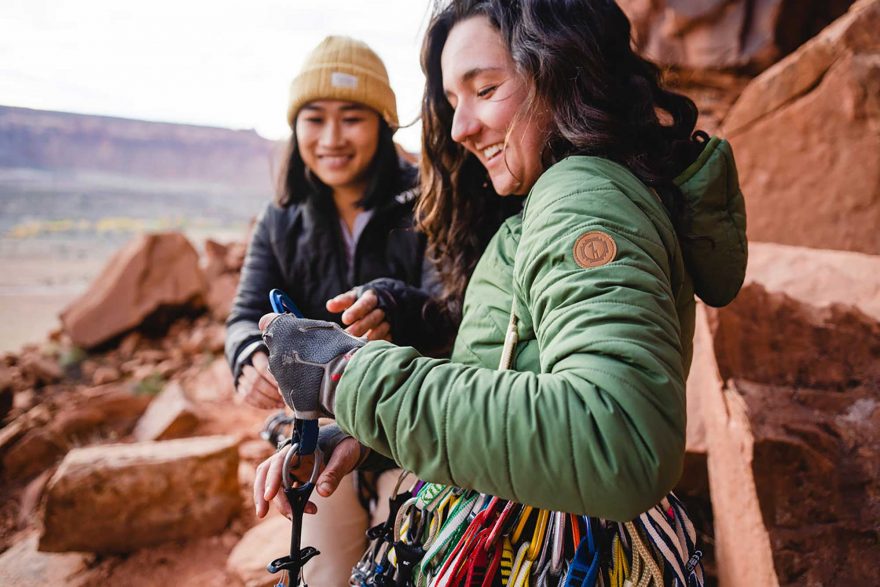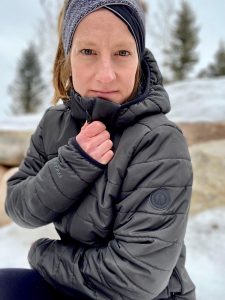
Image courtesy of Paka
I never thought I’d say this, but I caught myself sweating today. Outside. In January. On an easy walk along a snow-covered trail in the high mountains of Colorado under a cloudy sky. And no, I’m not feverish — I checked.
I’m not a heavy sweater. Even after my longest runs in the heat of summer, you won’t often find my forehead glistening or salty white lines marking the collar of my shirt. This is normally something I’m pretty pleased about. I don’t think I would appreciate feeling like I just stepped out of the shower every time I pick up the pace.
This time, though, the sweat came as a pleasant surprise. I’d headed out the door into sub-freezing Colorado temperatures wearing nothing more on my upper half than a single long-sleeved baselayer and the new PAKAFILL Lightweight Puffer Jacket from Paka. My goal was to walk as slowly as possible (a big ask for this chronically anxious athlete) and see how far I could get before the chill forced me to retreat. I didn’t plan on making it further than the first turn about half a mile down the trail.
Nearly two hours later, I finally wound up back at the trailhead. I’d finished the entire 5-mile loop without so much as a shiver.

The PAKAFILL Lightweight Puffer (Image by Lucie Hanes)
Since then, the PAKAFILL Puffer has come with me everywhere. I’m quite literally afraid of extreme cold after too many close calls with hypothermia, frostbite, and various injuries from a lack of feeling in my extremities. And even in less dramatic circumstances, the effect of the cold on my mood puts a real damper on anything I do outside in the winter. And I have a habit of wearing my emotions on my sleeve…so no one else in my vicinity is too happy about the situation either.
But this jacket could change all of that. On its own, I’m pretty comfortable down to 15 to 20 degrees (a pretty average daily high in my neck of the woods). Add another layer underneath and I can venture out in 5 degree temps. Two layers plus the PAKAFILL got me through a -2 degree morning. With each test, I grew more and more confident that Paka might really be onto something.
The History of PAKAFILL
Kris Cody, the founder and CEO of Paka, took a similar approach to the testing process … except his version puts mine to shame. He chose to take the first iteration of the PAKAFILL Puffer on an alpine expedition to the summit of Yanapaccha — a 17,913-foot-tall peak in Peru. It was the only outerlayer he and his partner, Peruvian mountaineer Jose Mostajo, wore on the trip. If they could stay warm in such extreme conditions, he reasoned, then there wouldn’t be much this jacket couldn’t handle. A successful summit by the two climbers sealed the deal.

Paka founder Kris Cody on his Peruvian mountain summit trip. (Image courtesy of Paka)
The stubborn, cynical part of me had wanted to prove him wrong. The optimistic side is overjoyed that I didn’t. I now fully believe that PAKAFILL has the potential to completely overhaul the outerwear industry to everyone’s benefit.
The technology even won a 2023 Outdoor Retailer Innovation Award.
Why Alpaca Fibers?
I’ve long been on the hunt for the perfect puffer. Nothing has quite satisfied my desire for a jacket that’s lightweight and low-profile without compromising on warmth or durability. The PAKAFILL Jacket (the women’s and men’s versions) is the first to tick all the boxes for me.
That’s because it’s the first of its kind. This jacket uses alpaca fiber for insulation instead of down feathers or synthetics. Alpacas live in the high country at elevations up to 14,000 feet, so their fibers can withstand a wide range of environmental conditions. Paka harnesses this “natural technology” to create a new kind of insulation that handily outperforms its competitors.
PAKAFILL insulation boasts a 2.59 thermal CLO value — more than any synthetic jacket out there can speak of — while taking up about half the space of a down jacket with the same warmth rating. And unlike down, alpaca fibers don’t wilt when wet. That makes PAKAFILL both safer and more practical.
An Ethical Alternative
But performance isn’t the only important factor here. Traditional insulation materials come with their fair share of baggage. Synthetic insulation contributes to microplastic pollution. The process of plucking down feathers causes undue harm to ducks and geese. PAKAFILL offers an ethical alternative to down and synthetic insulation.
“It’s a fully circular relationship between the farmers and the production process,” explains Zael Ellenhorn, chief marketing officer for Paka. “We maintain a very close relationship with our farmers and work with them to achieve each of our end goals: keeping the alpacas healthy and putting their discarded fiber to good use.”
That relationship is so close that all Paka products can be traced back to the source of their fibers, down to the exact coordinates.
Sharing is Caring
Cody and his team have created something special. Powerful thermoregulating properties, effective protection against a wide range of elements, and high ethical standards put PAKAFILL in a class of its own. But they don’t actually want to stand alone.
“We didn’t make it for us,” Ellenhorn says. “This is too valuable a discovery to keep to ourselves. We want to give it away to other companies too so that we can make a real impact.”
This means that top apparel brands can integrate PAKAFILL into their own designs, choosing it for their insulation needs over down feathers or synthetic materials. Paka itself is just the beginning of a ripple effect throughout the entire outdoor industry.
Lucie Hanes is an avid writer and adventurer on rock and trail with a passion for sharing her outdoor enthusiasms through journalism and mental strength consultation.
 Your Privacy Choices
Your Privacy Choices
 The
The